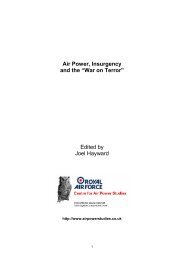Air Power, Insurgency and the âWar on Terrorâ - Prof. Joel Hayward's ...
Air Power, Insurgency and the âWar on Terrorâ - Prof. Joel Hayward's ...
Air Power, Insurgency and the âWar on Terrorâ - Prof. Joel Hayward's ...
You also want an ePaper? Increase the reach of your titles
YUMPU automatically turns print PDFs into web optimized ePapers that Google loves.
Starting with a Blank Sheet: Principles of War for a New Century<br />
well as quantity is important. Perhaps most importantly, however, is <str<strong>on</strong>g>the</str<strong>on</strong>g> dominance that<br />
<str<strong>on</strong>g>the</str<strong>on</strong>g> US enjoys in power-projecti<strong>on</strong> forces. At <str<strong>on</strong>g>the</str<strong>on</strong>g> present time <str<strong>on</strong>g>the</str<strong>on</strong>g>re are slightly over 1,100<br />
large cargo aircraft in <str<strong>on</strong>g>the</str<strong>on</strong>g> world. The US has over 700 of <str<strong>on</strong>g>the</str<strong>on</strong>g>m (all in <str<strong>on</strong>g>the</str<strong>on</strong>g> USAF), which is<br />
63 percent of <str<strong>on</strong>g>the</str<strong>on</strong>g> world total. There are also 825 aerial refuellers in <str<strong>on</strong>g>the</str<strong>on</strong>g> world: <str<strong>on</strong>g>the</str<strong>on</strong>g> US has<br />
707 of <str<strong>on</strong>g>the</str<strong>on</strong>g>m, or around 86 percent of <str<strong>on</strong>g>the</str<strong>on</strong>g> total. Most of <str<strong>on</strong>g>the</str<strong>on</strong>g> o<str<strong>on</strong>g>the</str<strong>on</strong>g>r large cargo aeroplanes<br />
<str<strong>on</strong>g>and</str<strong>on</strong>g> tankers bel<strong>on</strong>g to NATO countries. This incredible air mobility fleet allows <str<strong>on</strong>g>the</str<strong>on</strong>g> US<br />
<str<strong>on</strong>g>and</str<strong>on</strong>g> its allies to project power anywhere in <str<strong>on</strong>g>the</str<strong>on</strong>g> world, rapidly, <str<strong>on</strong>g>and</str<strong>on</strong>g>, just as importantly, to<br />
sustain those forces for an extended period of time.<br />
This has been dem<strong>on</strong>strated <strong>on</strong> a number of occasi<strong>on</strong>s over <str<strong>on</strong>g>the</str<strong>on</strong>g> past two decades. The<br />
Gulf War of 1991 saw mountains of materiel <str<strong>on</strong>g>and</str<strong>on</strong>g> hundreds of thous<str<strong>on</strong>g>and</str<strong>on</strong>g>s of pers<strong>on</strong>nel<br />
deployed to <str<strong>on</strong>g>the</str<strong>on</strong>g> Middle East. US airlifters – enabled by <str<strong>on</strong>g>Air</str<strong>on</strong>g> Force tankers – hauled 500,000<br />
people <str<strong>on</strong>g>and</str<strong>on</strong>g> 540,000 t<strong>on</strong>s of cargo into <str<strong>on</strong>g>the</str<strong>on</strong>g> <str<strong>on</strong>g>the</str<strong>on</strong>g>atre, making it <str<strong>on</strong>g>the</str<strong>on</strong>g> most massive airlift in<br />
history. During Desert Storm itself, <str<strong>on</strong>g>the</str<strong>on</strong>g> tankers flew 16,868 sorties to offload over 800<br />
milli<strong>on</strong> lbs. of gas in 51,696 hook-ups. On any given day tankers accounted for around<br />
20 percent of all Coaliti<strong>on</strong> sorties flown. Of importance, nearly <strong>on</strong>e-third of <str<strong>on</strong>g>the</str<strong>on</strong>g> aircraft<br />
refuelled by <str<strong>on</strong>g>the</str<strong>on</strong>g> tankers were from <str<strong>on</strong>g>the</str<strong>on</strong>g> US Navy, Marine Corps <str<strong>on</strong>g>and</str<strong>on</strong>g> Coaliti<strong>on</strong> countries. 490<br />
During <str<strong>on</strong>g>the</str<strong>on</strong>g> decade-plus following Desert Storm, <str<strong>on</strong>g>the</str<strong>on</strong>g> US <str<strong>on</strong>g>and</str<strong>on</strong>g> its allies flew over 300,000<br />
sorties in Nor<str<strong>on</strong>g>the</str<strong>on</strong>g>rn <str<strong>on</strong>g>and</str<strong>on</strong>g> Sou<str<strong>on</strong>g>the</str<strong>on</strong>g>rn Watch over Iraq. Beginning in 1995 <str<strong>on</strong>g>the</str<strong>on</strong>g> implosi<strong>on</strong> of<br />
Yugoslavia was marked by a bloody civil war that saw NATO air power take an increasingly<br />
active role. In 1995 NATO deployed south for <str<strong>on</strong>g>the</str<strong>on</strong>g> c<strong>on</strong>flict in Bosnia, <str<strong>on</strong>g>and</str<strong>on</strong>g> in 1999 <str<strong>on</strong>g>the</str<strong>on</strong>g>y went<br />
back to <str<strong>on</strong>g>the</str<strong>on</strong>g> Balkans to protect <str<strong>on</strong>g>the</str<strong>on</strong>g> Kosovars. Late 2001 <str<strong>on</strong>g>and</str<strong>on</strong>g> early 2002 saw <str<strong>on</strong>g>the</str<strong>on</strong>g> destructi<strong>on</strong><br />
of al Qaeda terrorist camps in Afghanistan <str<strong>on</strong>g>and</str<strong>on</strong>g> <str<strong>on</strong>g>the</str<strong>on</strong>g> overthrow of <str<strong>on</strong>g>the</str<strong>on</strong>g> Taliban regime. In<br />
2003 came <str<strong>on</strong>g>the</str<strong>on</strong>g> removal of Saddam Hussein.<br />
During all of <str<strong>on</strong>g>the</str<strong>on</strong>g>se operati<strong>on</strong>s air refuelling was essential. Tankers refuelled deploying<br />
fighters from all <str<strong>on</strong>g>the</str<strong>on</strong>g> services <str<strong>on</strong>g>and</str<strong>on</strong>g> allied countries to bases in <str<strong>on</strong>g>the</str<strong>on</strong>g> crisis regi<strong>on</strong>s; <str<strong>on</strong>g>the</str<strong>on</strong>g>y <str<strong>on</strong>g>the</str<strong>on</strong>g>n<br />
refuelled <str<strong>on</strong>g>the</str<strong>on</strong>g> airlifters maintaining <str<strong>on</strong>g>the</str<strong>on</strong>g> air bridge between <str<strong>on</strong>g>the</str<strong>on</strong>g> <str<strong>on</strong>g>the</str<strong>on</strong>g>atres <str<strong>on</strong>g>and</str<strong>on</strong>g> <str<strong>on</strong>g>the</str<strong>on</strong>g> US; <str<strong>on</strong>g>and</str<strong>on</strong>g><br />
<str<strong>on</strong>g>the</str<strong>on</strong>g>y also refuelled US <str<strong>on</strong>g>and</str<strong>on</strong>g> coaliti<strong>on</strong> aircraft throughout <str<strong>on</strong>g>the</str<strong>on</strong>g> combat operati<strong>on</strong>s <str<strong>on</strong>g>the</str<strong>on</strong>g>mselves.<br />
The increased dem<str<strong>on</strong>g>and</str<strong>on</strong>g> for tankers has been due to several factors. The reducti<strong>on</strong> of overseas<br />
bases by two-thirds in <str<strong>on</strong>g>the</str<strong>on</strong>g> aftermath of <str<strong>on</strong>g>the</str<strong>on</strong>g> Cold War meant that deploying aircraft would<br />
have to fly far<str<strong>on</strong>g>the</str<strong>on</strong>g>r to arrive at a crisis area. Up<strong>on</strong> arrival, <str<strong>on</strong>g>the</str<strong>on</strong>g> expediti<strong>on</strong>ary bases <str<strong>on</strong>g>the</str<strong>on</strong>g>n used<br />
were often a great distance from <str<strong>on</strong>g>the</str<strong>on</strong>g> targets to be struck. This was especially true for both<br />
l<str<strong>on</strong>g>and</str<strong>on</strong>g> <str<strong>on</strong>g>and</str<strong>on</strong>g> carrier-based strike aircraft hitting targets in l<str<strong>on</strong>g>and</str<strong>on</strong>g>-locked Afghanistan. Finally,<br />
<str<strong>on</strong>g>the</str<strong>on</strong>g> shift to fleeting <str<strong>on</strong>g>and</str<strong>on</strong>g> time-sensitive targets means a greater dem<str<strong>on</strong>g>and</str<strong>on</strong>g> for persistence, a<br />
capability provided by air refuelling. All of <str<strong>on</strong>g>the</str<strong>on</strong>g>se c<strong>on</strong>diti<strong>on</strong>s are likely to remain in effect<br />
for <str<strong>on</strong>g>the</str<strong>on</strong>g> foreseeable future.<br />
200<br />
<str<strong>on</strong>g>Air</str<strong>on</strong>g> <str<strong>on</strong>g>Power</str<strong>on</strong>g>, <str<strong>on</strong>g>Insurgency</str<strong>on</strong>g> <str<strong>on</strong>g>and</str<strong>on</strong>g> <str<strong>on</strong>g>the</str<strong>on</strong>g> “War <strong>on</strong> Terror”





